Tom Wilson June 01, 2022 All Feature Vehicles
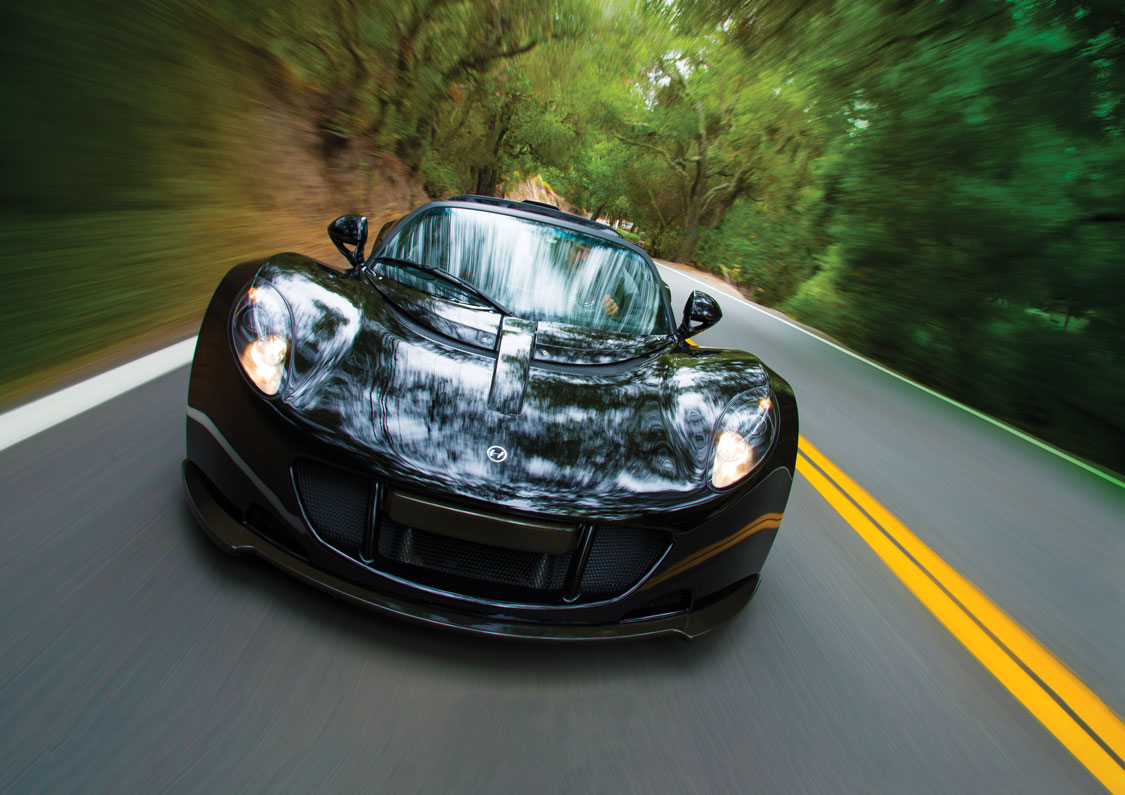
John Hennessey’s Venom GT is a car that will make you sweat. No matter how many hot rods you’ve driven, this one has so much thrust in a snake-fast chassis that after 20 minutes we felt as wound up as a garage-door spring. We doubt we would have relaxed after 20 hours, or maybe even 20 years. And we loved it.
Our date with Hennessey took place in Lake Forest, California, at his new parts-installation outpost. Chaperoned by Douglas Kott, Hennessey’s man behind the media coverage, the Venom in question is one of 12 built so far and is fittingly owned by Aerosmith front man Steven Tyler. While Tyler has absolutely no issues standing out —even when visiting Southern California (he keeps his Venom GT at Hennessey’s shop)—he also has no worries about seeing himself coming the other way. That’s because the Venom GT production run is slated to never exceed 29—a number Hennessey purposefully selected to remain at least one car more exclusive than its top-speed sparring partner, the Bugatti Veyron Super Sport.
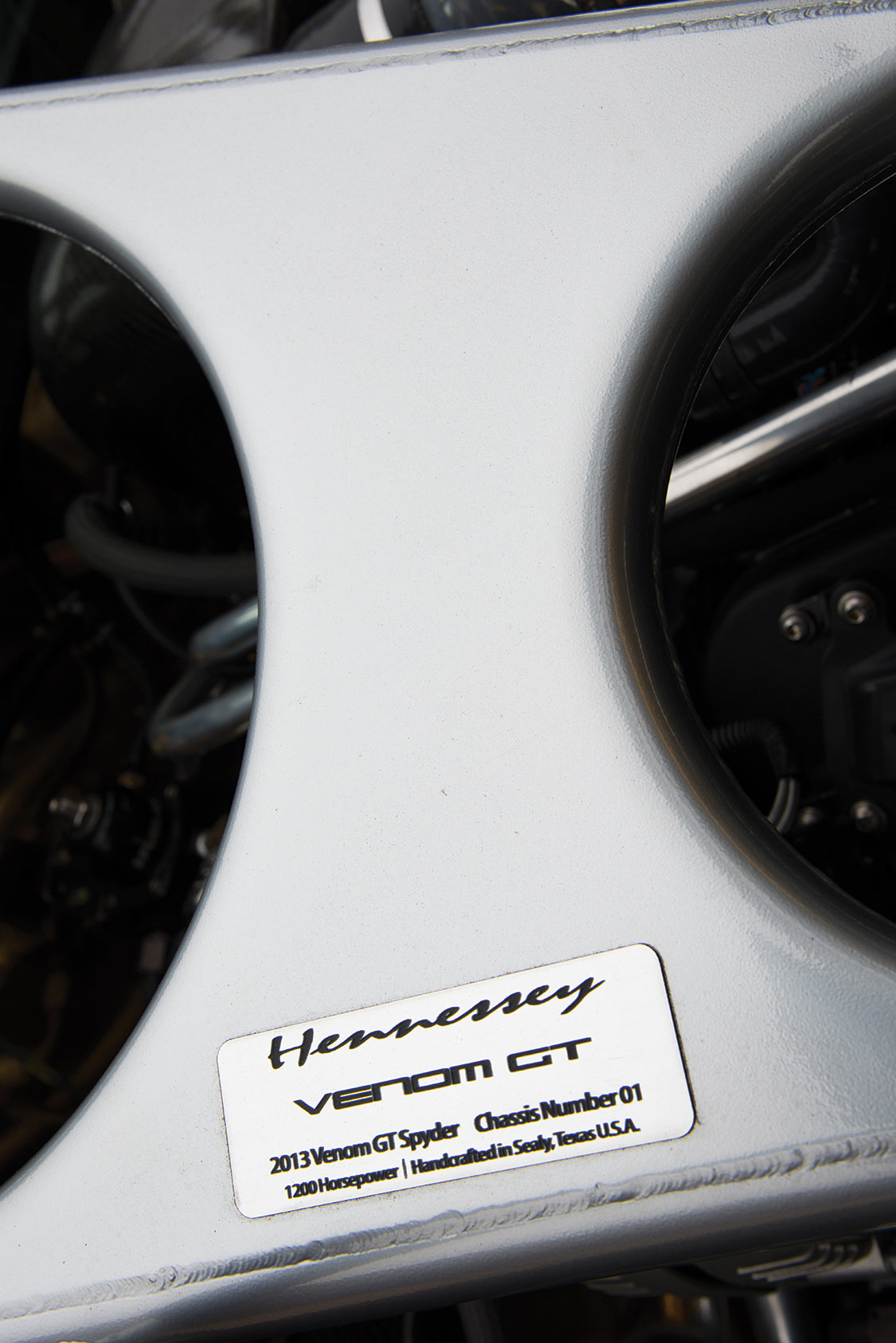
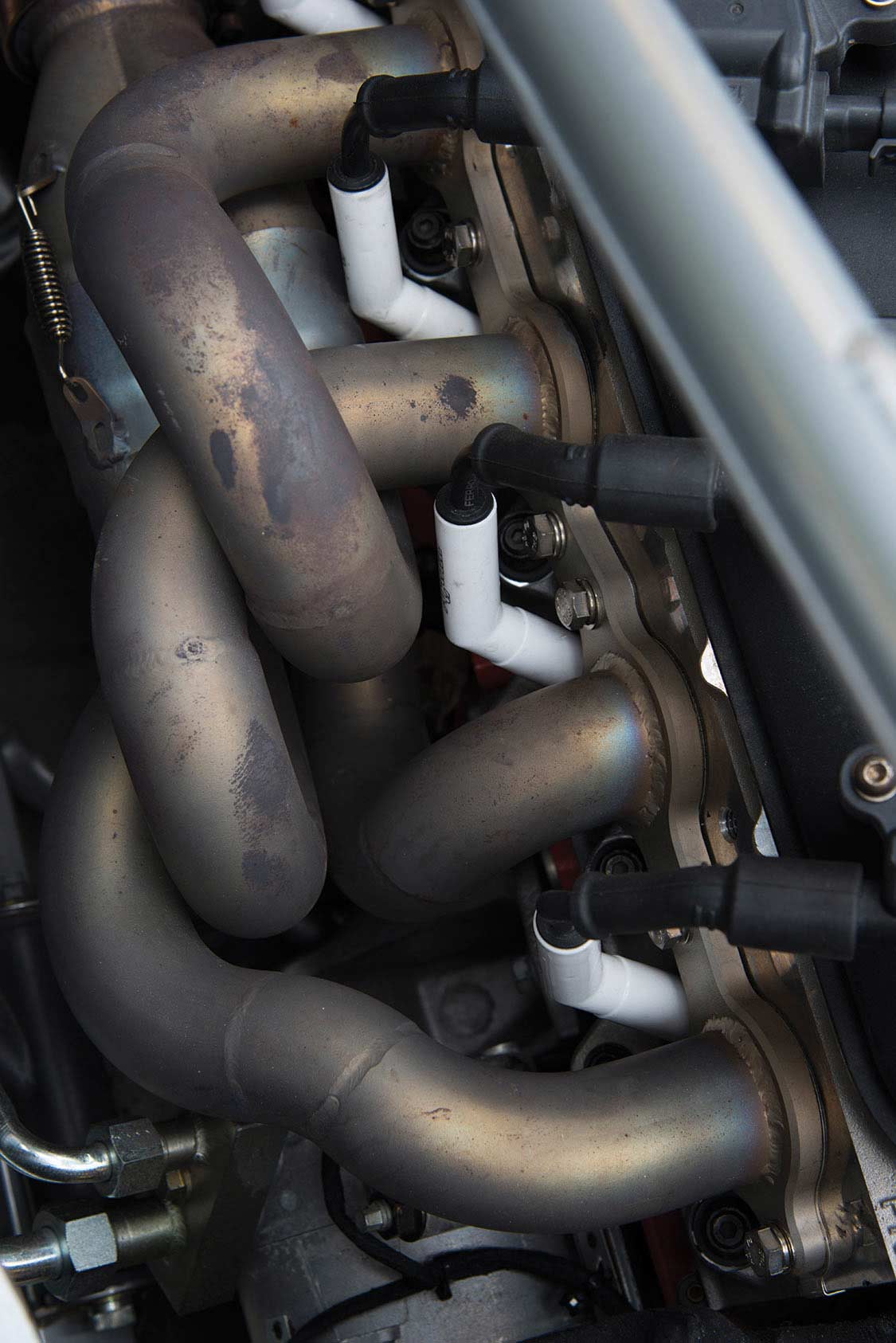
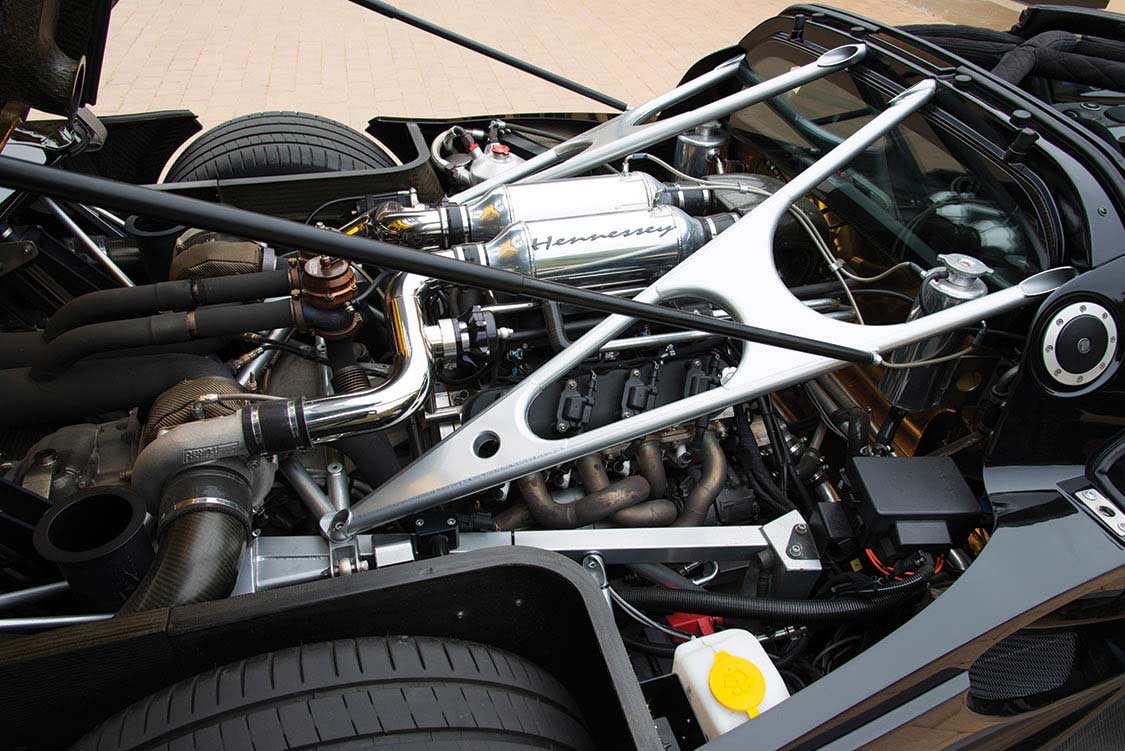
Additionally, Tyler’s car is first in an even more exclusive run of Venom GT Spyders, so instead of something as prosaic as the standard Venom GT’s air-scooped roof, a padded “X” of roll bar bracing defines the Spyder cockpit’s upper terminus. It’s California; we don’t ask if there’s a targa-type roof panel, and we’d be disappointed if there was.
Despite all the pit-rail chatter that it looks too much like its Lotus underpinnings, the Venom GT’s visual presence is unique and exciting. Unlike most mid-engine hyper cars it isn’t huge, but rather thigh-high with just enough length to telegraph the seriousness contained in the amidships engine room. Indeed, the doors and cockpit are almost purely unmolested Exige bits, and the front design remains unashamedly Lotus-like even after being re-rendered over a foot wider. So while the Venom GT does look Chapman-esque in photos, in person, the unmistakable rear mass coupled with the dramatically wider stance instantly stand the Venom GT apart.
So although it does all begin with a Lotus, once all the abbreviations are accomplished, the Exige donates little more than its cockpit, climate control and a few body parts to the final product. Behind the cockpit is all Hennessey. The wheelbase is lengthened 19.7 in., better to accept a Chevrolet LSX-based engine and Ford GT transaxle drivetrain. The suspension is custom from Hennessey, as is the twin-turbo dressing the small block receives.
Hennessey rates the engine at 1244 hp at 6600 rpm and 1155 lb.-ft. of torque at 4400 rpm. Adequate for any need, as the man from Rolls-Royce used to say.

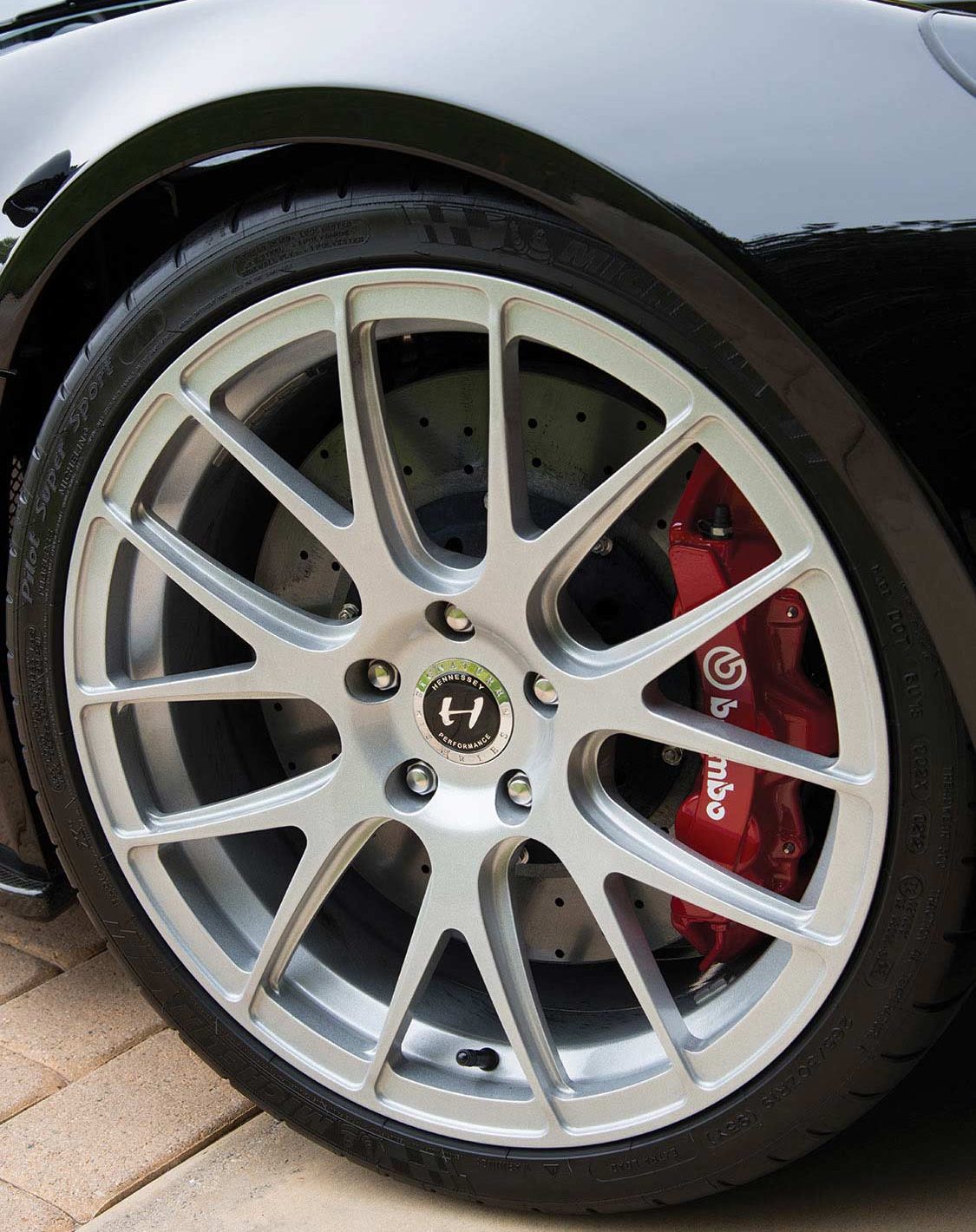
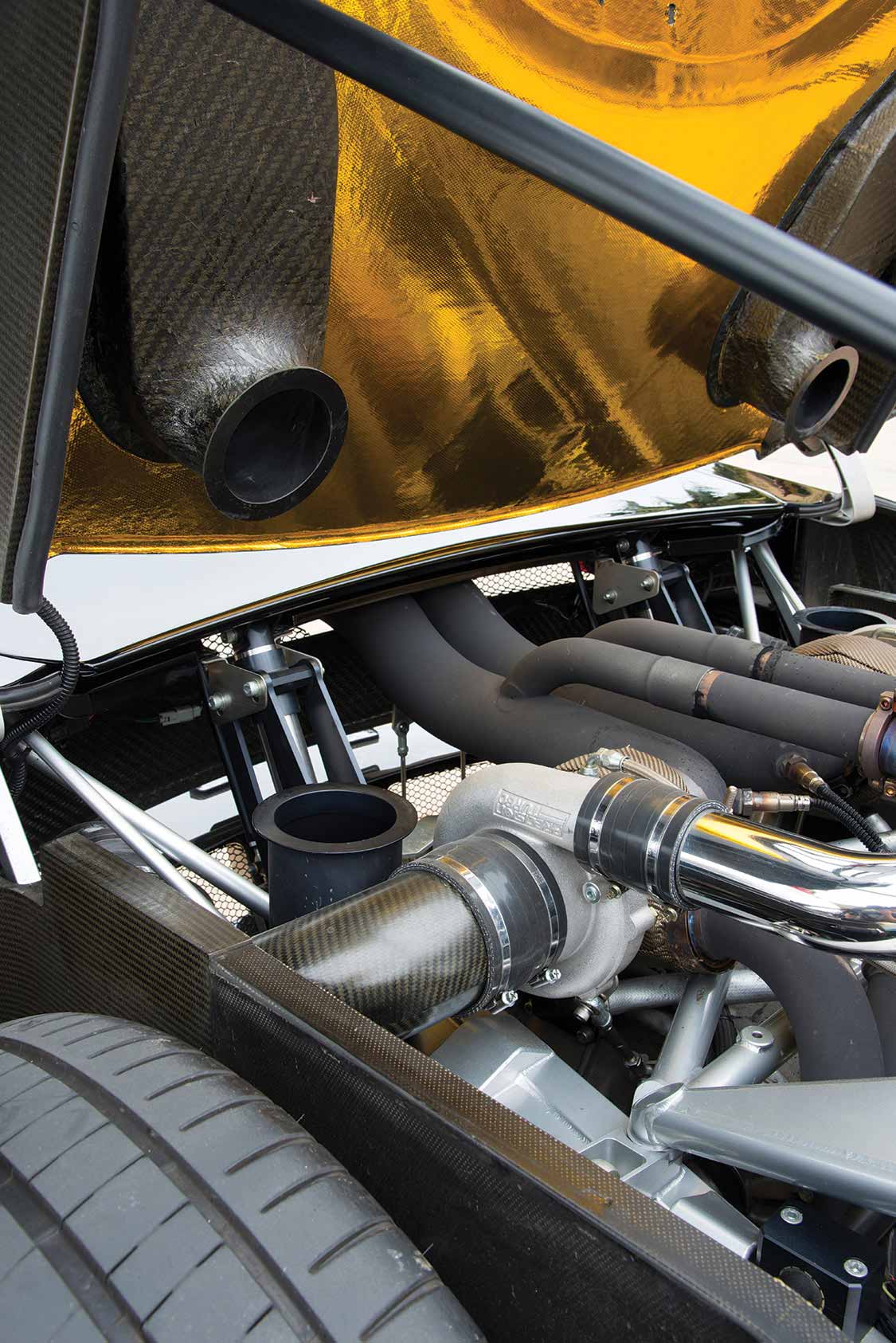
Fittingly, the 7.0-liter pushrod engine is built in Texas at the Hennessey shop. It’s full of high-strength forged-steel pieces, but as a turbo mill it doesn’t need some of the more involved treatments that a high-compression, naturally aspirated engine would. Instead, the emphasis is on strength to keep the huge cylinder pressures from sweating out, plus keeping the highly tasked block square and the cylinders round. Most tellingly, the aluminum block is sleeved with Darton’s iron dry-sleeve kit before being buttoned up with Cometic’s best gaskets, CNC-ported aluminum cylinder heads and diamond-hard ARP fasteners. For ground clearance and durability, the engine is dry-sumped to allow a shallow, ground-hugging oil pan and a greater supply of lubricant. Hennessey rates it at 1244 hp at 6600 rpm and 1155 lb.-ft. of torque at 4400 rpm. Adequate for any need, as the man from Rolls-Royce used to say.
Behind the engine is a Ricardo 6-speed manual transaxle lifted from the Ford GT. Given the Ford’s similar road speed and engine rpm range, it’s no surprise that not a single gear ratio was changed for Venom duty.
Considerably more visible are a pair of art-deco aluminum Zeppelins masquerading as air-to-water charge coolers. Plus, there’s a symmetric maze of plumbing associated with the twin turbochargers and bits of artfully rendered tube-frame structure as it rises from the sea of mechanical hardware. It can’t help but look very sports racer, as if Hennessey had set out to build something for Sebring or Le Mans [not so] but decided to put it on the street instead.
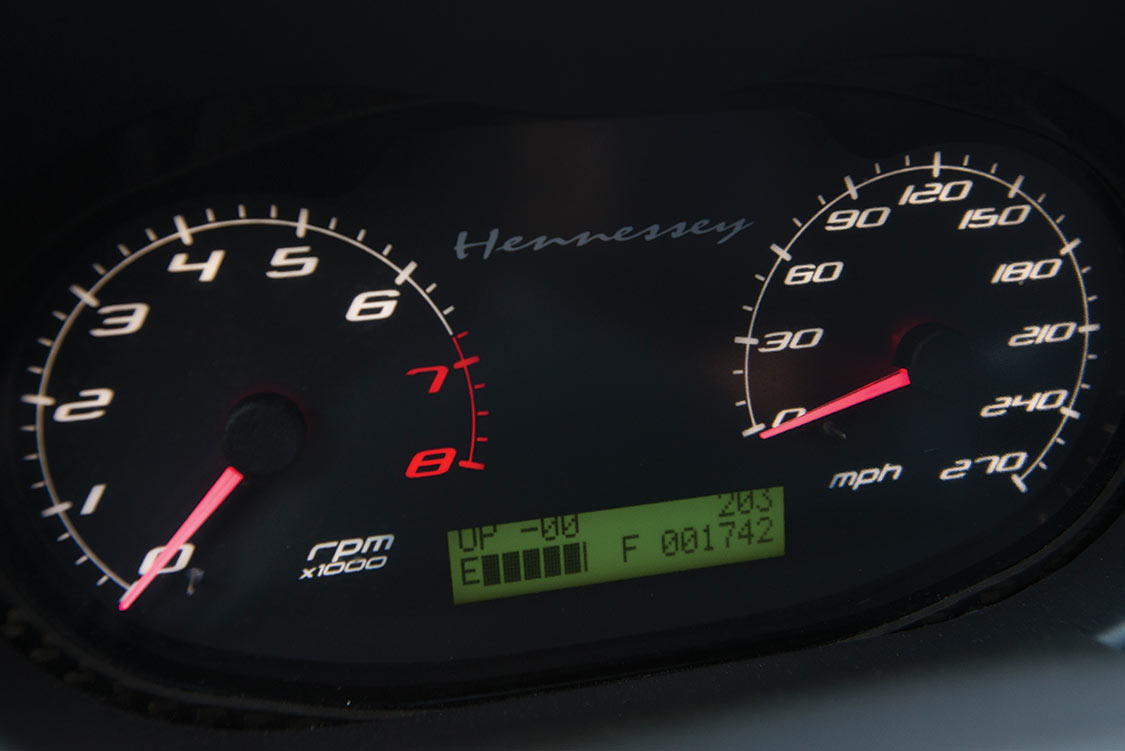
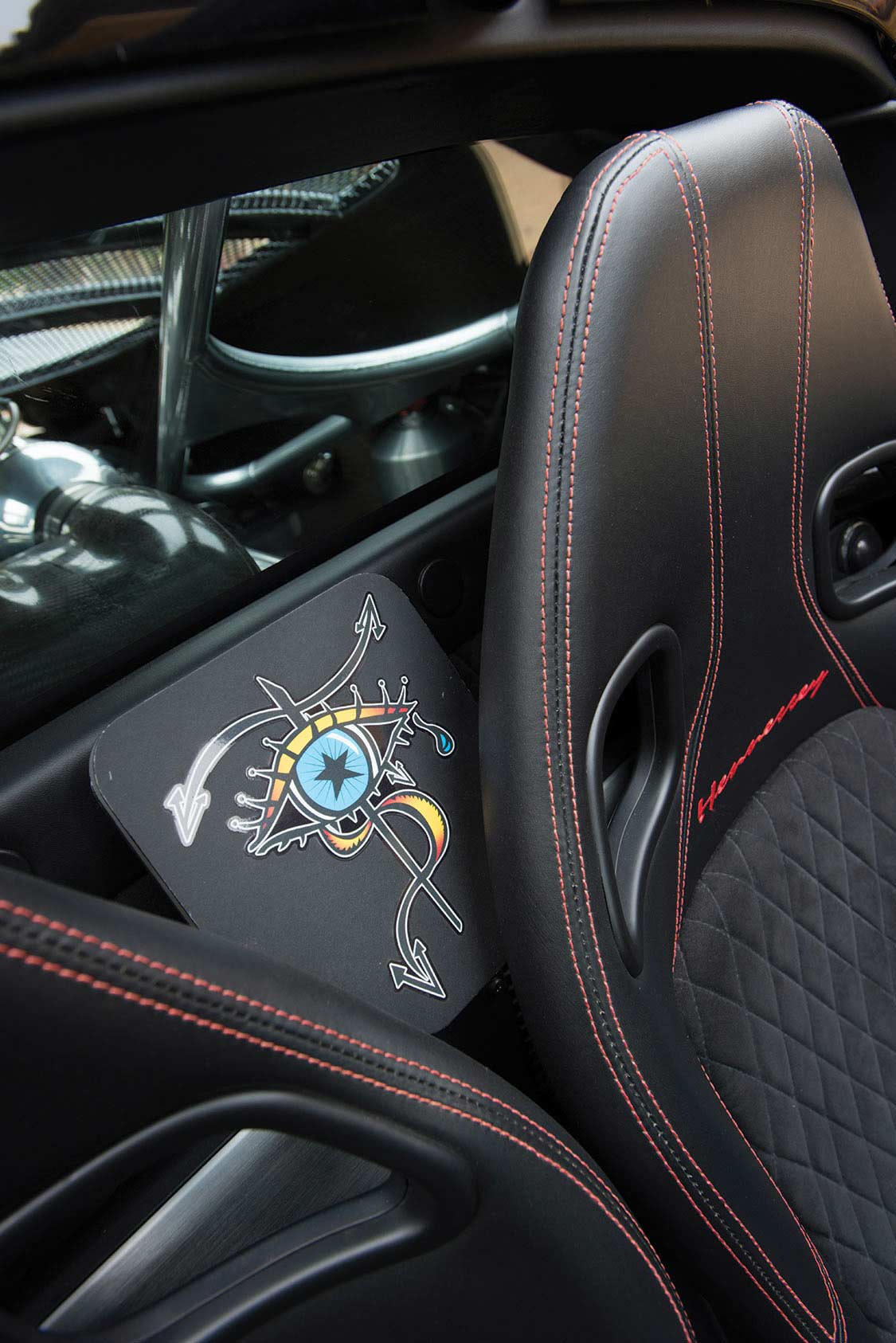
Finally, there is nothing left to do but climb in and see how good you are. The steering wheel detaches in race-car fashion but even with our 6-ft. 2-in. height and expense-accounted diet, it’s not necessary. If you’ve had the pleasure of driving an Elise or Exige, the minimalist cockpit is definitely familiar. There’s an engaging openness compliments of the unobstructed, center console-less footwell and large windshield. Surely, a Venom GT coupe would be more chicken-house than we’d like, our preferences run toward open cockpits and formula cars, so the sky-bright overhead and breezy feel are naturals.
Hennessey has eschewed racing harness seatbelts, sticking with the easily donned 3-point belts from the Lotus cockpit. We’re soon strapped in for our ride. The equally tall Kott is not so well accommodated. Apparently, a career of rock concerts has predisposed Tyler toward a concussion-on-demand sound system, and the passenger footwell is impeded by a large subwoofer. Granted, there is nowhere else for it, but given the Venom’s live entertainment behind your head, the stereo seems just too much weight.
Exactly as in a Lotus, the instrument cluster is somewhat out of sight, with too-small instruments mounted a bit too low for easy reading. The steering wheel does its best to stay out of the visual path to the instruments and is a proper racer piece with a solid aluminum frame and no airbag. Clad in plush Alcantara, it promises an honest, feedback-rich report on what the front tires are up to.
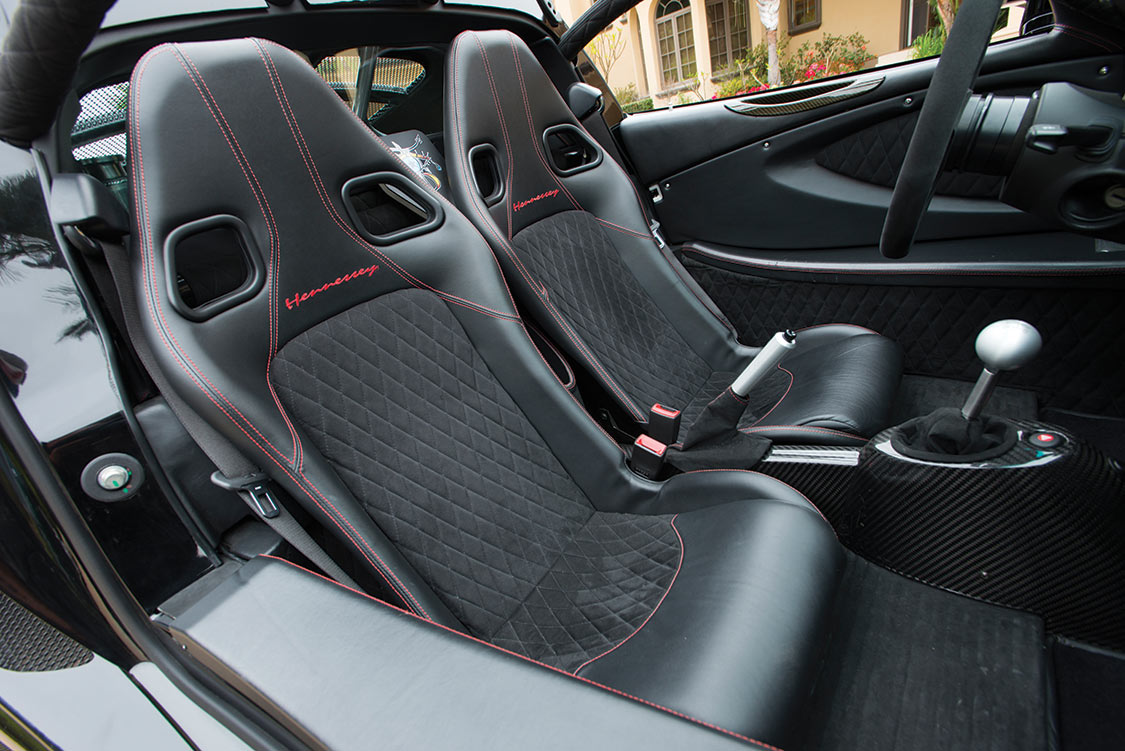
Start the engine and there’s a big, loud thump from the exhaust, highlighted by turbo whir even at idle. Underway, the noise level is elevated, the exhaust blare is always with you, punctuated by a sometimes cacophonous and other times motivating mix of turbo zoom, pop-off valve whoosh and drag-cam stutter. You won’t sneak this one home at night, but you will have fun making noise as the open top really lets in the details.
Maneuver number one is getting the Venom out the driveway. It’s crazy low, so an angled approach is mandatory and still we get a solid scrape from the front bodywork. Not to worry, advises Kott, it’s designed to take it. Later, we recall the car’s electrically adjustable ride height designed precisely for such crawling-speed clearance issues, but not in time to see how much it would help.
Underway the steering is heavy, with the same muscular effort from center to the locks. It’s quite race-car-like, and weighted enough to make us question just how fast we could even snap in opposite lock should it be necessary. Turns out the steering is electrically assisted, with a 6-position rotary knob that goes unseen and unused during our quick drive. Some at Hennessey prefer the extra feel from the no-assist position, explaining how we came to sample that effort. Dialing the knob gives rather noticeable increases in assist, says Kott.
And there is plenty to feel through the Lotus steering. The front tires lightly nibble, every undulation on the pavement reaching your hands, giving endless feedback on all but billiard-table smooth highways. It’s all part of the steamroller tire and sports-car suspension geometry combination. It’s a big player in the Venom GT’s amped personality.
In contrast, shifting is Lotus-light and a pleasure. A well-weighted steel ball atop the spindle column gives inertia through the gates, and the throws are perfectly short. Like any good hot rod, the Venom gearbox crunched into 2nd gear when cold, but proved unwaveringly slick once warmed.
a career of rock concerts has predisposed Tyler toward a concussion-on-demand sound system, and the passenger footwell is impeded by a large subwoofer.
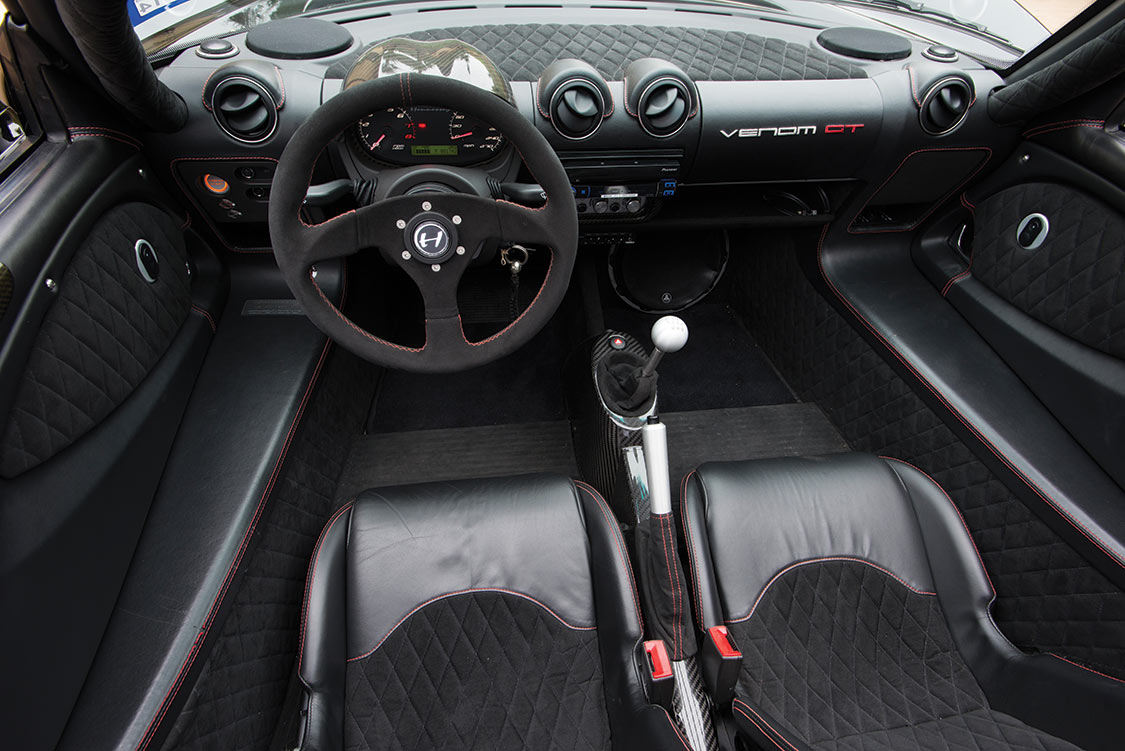
So we trundle through the usual 35-mph compulsories between stoplights, getting to know just how feral this beast is. The forward view is good, save for the windshield header blocking nearby objects such as traffic signals; rear vision is near nil. The fenders block the view for the outside mirrors and the fastback’s mesh grilles make visual hash out of whatever is going on behind. Another minor distraction is the turn-indicator stalk is a long way from the steering wheel.
Finally, the road straightens and is four lanes wide. We ease the Venom through 1st gear, then squeeze the right pedal.
Well, it certainly has some power.
More precisely, the Venom has a 3-step power knob that toggles the tune from 800 hp to 1000 hp, ultimately claiming 1244 hp. The first notch is enough, we assure you, and perhaps even more sacrilegiously, the rig’s drag-racing derived traction control is a godsend. It allows tire-boiling wheelspin if that’s your thing, but more realistically, it makes launching hot, straight and reasonably low effort, something it most assuredly would not be without the undetectable-to-the-driver electronic aid. In fact, the toughest part of starting out is the short, slightly high-effort clutch coupled with a quick-on-the-draw throttle. It takes some technique to get it just right, and just as realistically, is something Hennessey tuners can address so your experience may vary.
We hit it again. Sweet.
And again, a few minutes later. You can’t help it, really. The sound and rush are intense but over far too soon. Heck, it hits 100 mph in 5.6 sec., and in less than that from a roll. Hardly long enough to enjoy it. Even a quarter mile is over in 9.9 sec. at 163 mph. You could get in trouble with this on the street, but until then it just makes you giggle.
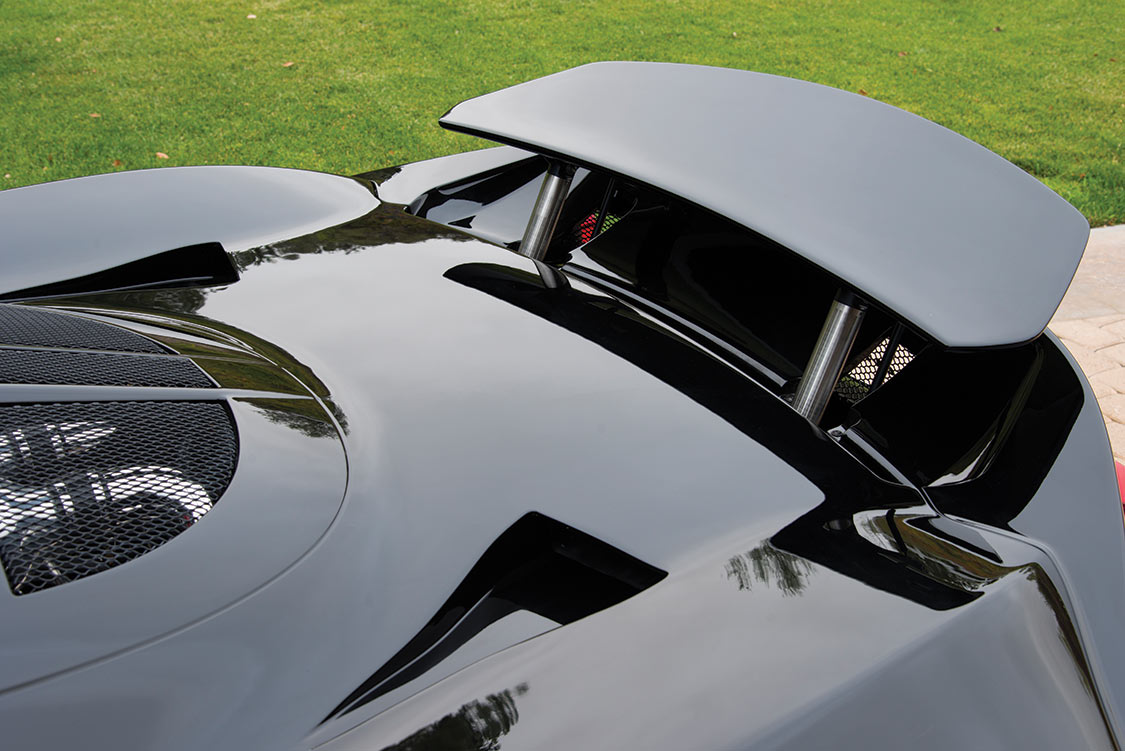
What sticks is how hard it accelerates long after any normally over-powered car would be feeling the wind. But we’re only reaching half of the Venom’s 271 mph demonstrated top speed and it’s still charging toward escape velocity like it really intends to get there. And yes, in daily driving, just a whiff of throttle puts the rabble satisfyingly astern.
We mainly coast down from speed but the brakes are definitely there for you. Wonderfully, the pedal is straight out of a Trans-Am race car: rock hard and it moves maybe a millimeter. It demands effort from the driver, a conviction to slow, and then the carbon-ceramic Brembos do their thing with authority. The effort is like typical power brakes without the power—in other words, like 1965 performance brakes in effort, but with a much better pedal feel and way better results. Impressively, the binders take little warm up, and best of all, the pedals are perfectly set for heel-and-toe operation.
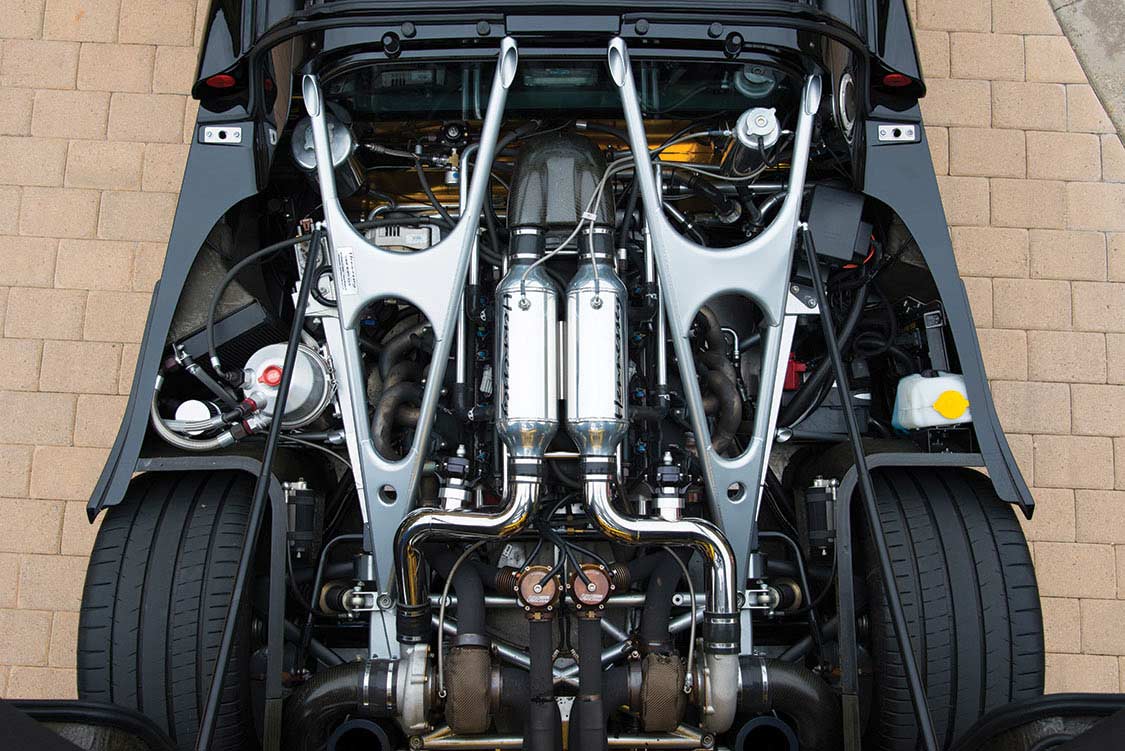
Knowing we wouldn’t dare try too hard, we sought out a twisty canyon to sense what left-right-left zippiness this longer-wheelbase had maintained. Plenty more than we were willing to risk with this much power underfoot and no stability control. Call us a bit chicken, but please understand the cornering remains kart quick—way quicker than any normal human’s ability.
So we hit it again on a straight, but this time the clutch slipped at the torque peak, so we motored back to the shop. A shame, but it’s probably why we’re still not scraping together bail instead of writing this review.
And there is plenty to feel through the steering. every undulation on the pavement reaching your hands, giving endless feedback on all but billiard-table smooth highways.
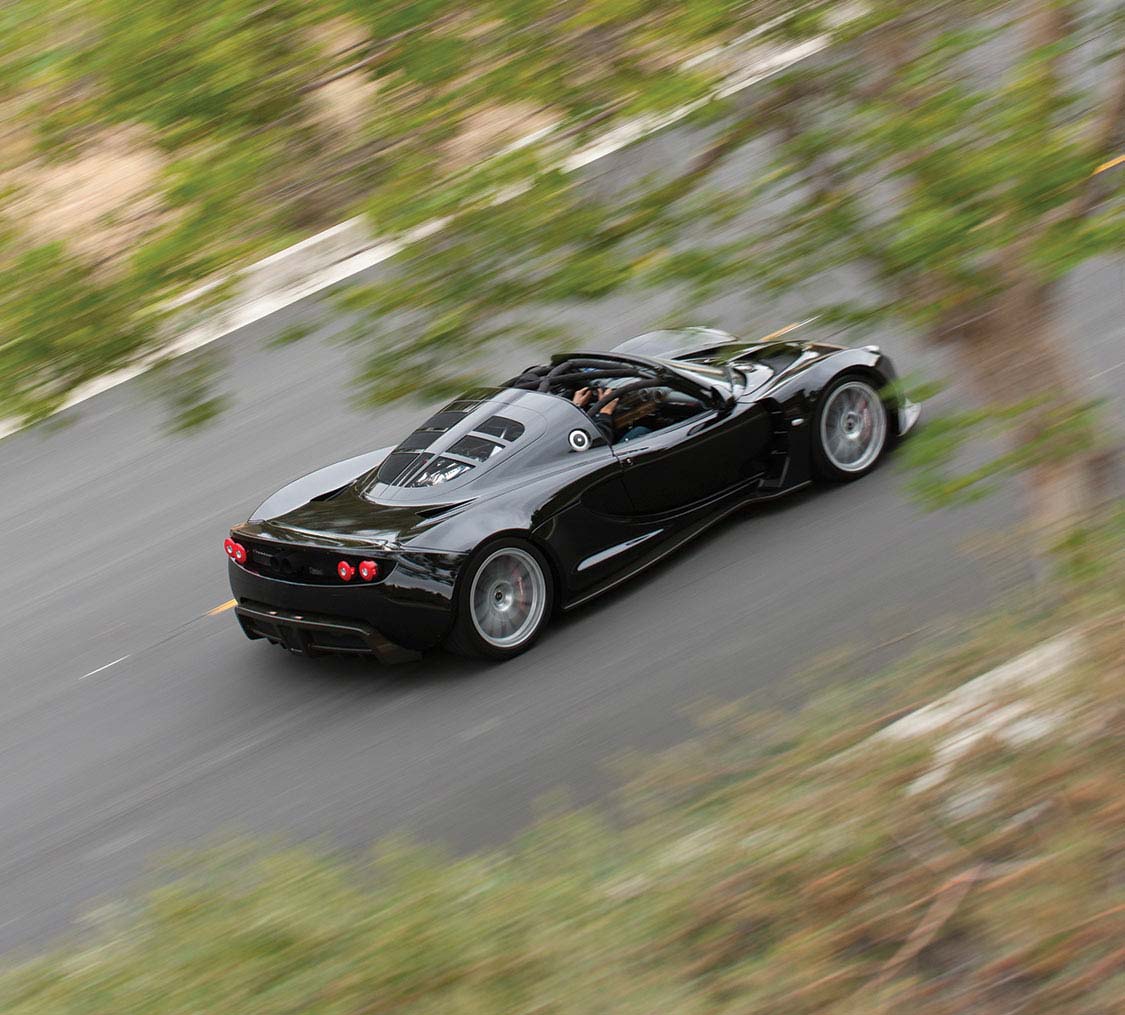
Such operational challenges have always been the nature of hot rods such as the Venom GT. Although much of the car comes from established production engineering, plenty also speaks of late nights in the garage and a strong personality focused on a go-fast goal. Tuned for glory, this Hennessey exudes an undomesticated pheromone that makes you want to crawl into your Nomex, sneak outside at 3 a.m., fire up the Venom GT and go. That right there is the attraction. It’s the Venom’s deviant mission and its sharply hewn edges that gouge at the brain, not the slick bits. It’s the short, moderately heavy clutch. The light shifter. A brake pedal that barely moves but responds to heavy pressure. A mere suggestion of any useful rear vision. And Hand of God power.
In the end, these are the gears in the Venom GT’s adrenaline pump, the stuff that keeps you alive. It’s easy to see why Tyler has one.
Tom Wilson’s first car was a G Production Austin-Healey Sprite that made almost as much power as the Venom’s starter motor.
If the Venom GT is the best street drive you’ve ever known or could even imagine, that’s because sweat-inducing automotive thrills is what Hennessey Performance Engineering (HPE) manufactures. Started by a youthful, speed-addicted John Hennessey in 1991 with a Mitsubishi 3000GT that—like seemingly every car he’s ever met, wasn’t fast enough—Hennessey has built a remarkable nerve-tingling string of powerful and speedy cars. After modding that first turbocharged Mitsubishi, he turned to Dodge Vipers. By 1994, Hennessey Viper engine hardware was racing at Le Mans and people were starting to notice.
there’s a big, cammy thump from the exhaust, highlighted by turbo whir.
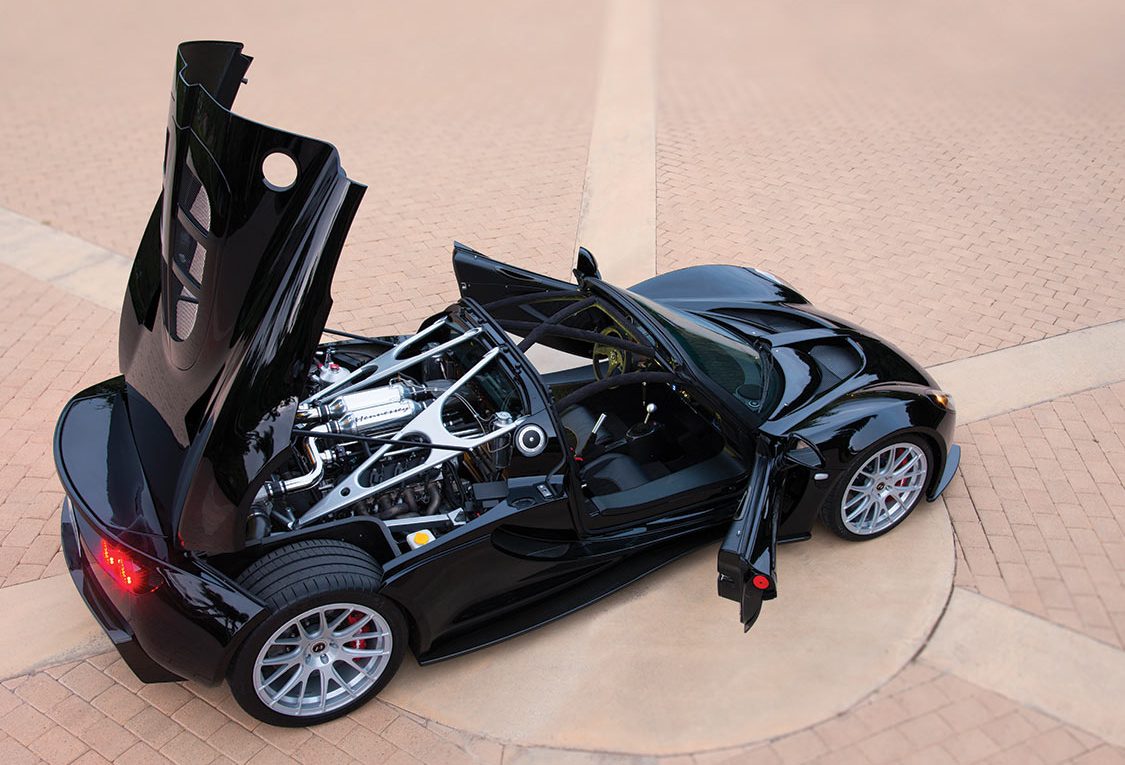
Five years on, the modified Vipers were named Venom 800s, with Hennessey-brewed twin-turbo power good for a finger-snapping 2.9-second 0–60-mph sprint, 9.9 sec. in the quarter mile and 197 mph in the standing mile. It was the sort of performance that writes headlines, and Hennessey cars became regulars on magazine covers. The huge power attracted readers as well as customers who didn’t seem to mind paying a premium for the most outrageous tuner cars in North America. By 2004, Hennessey Performance had a dozen employees and its own 143-acre Lone Star Motorsports Park, complete with a drag strip, in Sealy, Texas.
While a dedicated home base was a sure move to stability for HPE, a year later the most fundamental improvement came when Don Goldman began his relationship with the energetic but somewhat disjoined company. The recently retired Goldman found he could only play so much golf, and his skills righting foundering businesses was exactly what the idea-rich but detail-deficient Hennessey needed.
Hennessey Performance more recently added a satellite facility in Lake Forest, California. Right in the heart of Southern California’s Orange County car culture, Hennessey West installs and services the hardware developed in Texas.
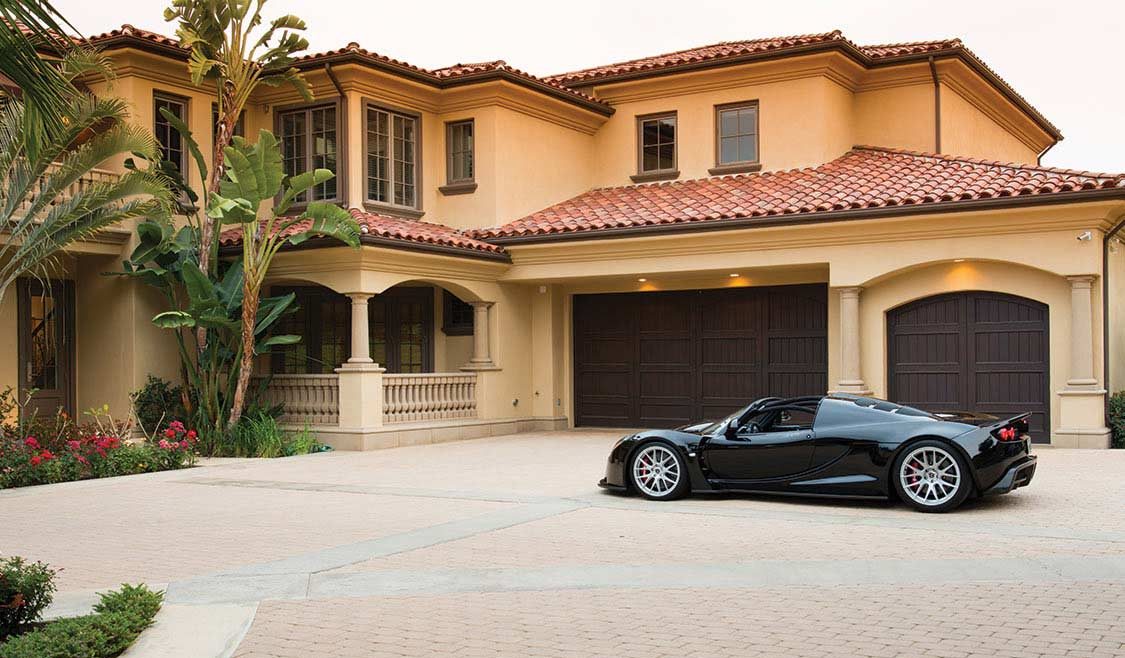
Today, the numerous cars emerging from the Texas facility range from American muscle such as Vipers and Dodges, to the entire catalog of GM performance vehicles, to Ford’s giddy-up stable. In a huge advancement over the learn-by-doing pathway that hot-rodders have taken since they were rolling up boxes of cigs in their shirtsleeves, HPE also formed its own proprietary Tuner School (www.TunerSchool.com). It’s a huge head start in hot-rodding for 14 students per semester, with under-hood wrench sessions backed by structured classroom work. With tuition, lab and application fees, Tuner School is a $14,650 investment for the budding power builder. Upon completing the program, grads receive a certificate, job placement and referral services (more than one grad is working in Hennessey’s main shop). Future students might also soon enjoy the financial aid packages HPE is currently developing.—Tom Wilson
2014 Hennessey Venom GT
The Venom GT design is based on the Lotus Elise and Exige, and utilizes components including the roof, doors, side glass, windscreen, dash, cockpit, floor pan, HVAC system, windshield wipers and headlights.
PERFORMANCE |
|
| 0–60 mph | 2.7 sec. |
| 0–100 mph | 5.6 sec. |
| 0–300 km/h | 13.63 sec. – Guinness World Record |
| 0–200 mph | 14.51 sec. – Hypercar World Record |
| ¼ mile | 9.92 sec. @ 163 mph |
| Standing half-mile | 206 mph |
| Standing mile | 253 mph |
| Verified top speed | 270.49 mph |
| Estimated top speed | 278 mph |
ENGINE |
|
| Type | 90-degree V-8 |
| Valvetrain | Overhead valve, 2 valves per cylinder |
| Block/heads | Iron/aluminum |
| Forced induction | Twin turbochargers |
| Horsepower | 1244 hp @ 6600 rpm (cockpit-adjustable to 800, 1000 and 1244 hp) |
| Torque | 1155 lb.-ft. @ 4400 rpm |
| Displacement | 427 cu. in./7.0 liters |
| Compression ratio | 9.2:1 |
| Redline | 7200 rpm |
| Lubrication | Dry sump |
| Fuel injection | Electronic sequential multi-port |
CHASSIS |
|
| Layout | Mid-longitudinal engine |
| Body/frame | Carbon fiber and composite/aluminum hybrid monocoque space frame |
| Brakes, f & r | 15.0 x 1.3-in. carbon-ceramic rotors with 6-piston Brembo fixed calipers |
| Wheels | Hennessey H10 forged monoblock, 9.5 x 19 front, 12.5 x 20 rear |
| Tires | Michelin Pilot Super Sport 265/30ZR19 front, 345/30ZR20 rear |
| Steering | Rack & pinion, 6-position variable electric assist |
| Suspension, front and rear | Unequal-length tubular A-arms, anti-roll bars |
| Springs/shocks | Penske 2-way adjustable coilover |
| Ride height | Adjustable over 2.4-in. range |
DRIVETRAIN |
|
| Drive system | Rear-wheel drive |
| Transmission | Ricardo 6-speed manual |
| Final drive ratio | 3.36:1 |
| 1st gear ratio, max speed | 2.61:1, 69 mph |
| 2nd gear ratio, max speed | 1.71:1, 105 mph |
| 3rd gear ratio, max speed | 1.23:1, 146 mph |
| 4th gear ratio, max speed | 0.94:1, 191mph |
| 5th gear ratio, max speed | 0.77:1, 233 mph |
| 6th gear ratio, max speed | 0.63:1, 278 mph |
DIMENSIONS & CAPACITIES |
|
| Length | 183.7 in. |
| Width | 77.2 in. |
| Height | 44.7 in. |
| Wheelbase | 110.2 in. |
| Track, front | 63.5 in. |
| Track, rear | 63.2 in. |
| Ground clearance | 3.5 in. to 5.9 in. |
| Curb weight | 2743 lb. |
| Fuel capacity | 18.5 gal. |
| Weight distribution, f/r % (with driver & passenger) | 44/56 |
Options
Note: Hennessey Performance and the Venom GT are not associated with Lotus Cars.
For More Visit:
HennesseyPerformance.com